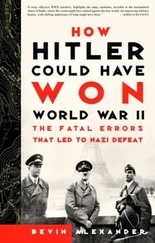24. Joseph Stalin with Joachim von Ribbentrop and Commissar Vyacheslav Molotov in 1939. (AFP/Gettyimages)
25. Soviet and Nazi troops at Brest-Litovsk. (akg-images/Alamy Stock Photo)
26. Wehrmacht troops storm the River Bug near Brest-Litovsk. (ullstein bild Dtl./Gettyimages)
27. The German invasion was spearheaded by panzer divisions. (Hulton Deutsch/Corbis Historical/Gettyimages)
28. Muscovites gather in the street to listen to the announcement of the German invasion. (TASS/Alamy Stock Photo)
29. Soviet soldiers captured by merciless German troops. (akg-images/Mondadori Portfolio)
30. Soviet prisoners of war being marched into captivity. (ullstein bild Dtl./Gettyimages)
31. Roosevelt and Churchill on board USS Augusta . (Fox Photos/Hulton Archive/Gettyimages)
32. Fires raged in towns and villages across the Barbarossa battleground. (ullstein bild Dtl./Gettyimages)
33. German soldiers advancing through a village set alight by Soviet troops. (Granger, NYC/Alamy Stock Photo)
34. Dmitri Shostakovich. (TASS/Alamy Stock Photo)
35. ‘General Mud’ severely disrupted the German advance. (ullstein bild Dtl./Gettyimages)
36. Many thousands froze to death during the winter of 1941. (LAPI/Roger Viollet/Gettyimages)
37. Bombing raid on Moscow. (Margaret Bourke-White/The LIFE Picture Collection/Gettyimages)
38. The military parade held in 1941 to mark the anniversary of the October Revolution. (TASS/Gettyimages)
39. Citizens shoring up the city’s defences against the panzers. (Time Life Pictures/The LIFE Picture Collection/Gettyimages)
40. Roosevelt addressing Congress the day after Pearl Harbor. (Fotosearch/Archive Photos/Gettyimages)
41. The German retreat from Moscow. (Scherl/Süddeutsche Zeitung Photo/Alamy Stock Photo)
42. Friedrich Jeckeln. (Yad Vashem, Photo Archive, Jerusalem. 1979/4)
43. At Babi Yar the SS murdered more than 30,000 Jews. (Pictures From History/Alamy Stock Photo)
44. By the end of the war 6 million Jews had been murdered by the Nazis. (VW Pics/Universal Images Group/Gettyimages)
45. A Soviet propaganda poster. (Photo 12/Universal Images Group/Gettyimages)
Maps
Preface
Hitler’s invasion of the Soviet Union on 22 June 1941 was the biggest, bloodiest and most barbarous military enterprise in the history of warfare. The specific purpose of Operation Barbarossa, as the Führer codenamed this cataclysmic venture, was also the most decisive campaign of the Second World War. Had Hitler achieved its objective – the annihilation of the Soviet Union – he would have been the master of Europe’s destiny. As it was, by the time his armies had reached the gates of Moscow less than six months later, any prospect he might once have had of realizing his delusional vision of a Thousand Year Reich had already vanished.
The Wehrmacht – the collective name for the German army, navy and air force – would, of course, go on to launch further major offensives and secure many dramatic victories as the war progressed. But these were ephemeral triumphs. By the end of 1941 at the very latest, the Nazis had already lost any realistic chance of winning the war. For three and a half more years the soil of Eastern Europe would be saturated in the blood of tens of millions of people, victims of a hideous endgame the outcome of which had already been ordained. Disconcerting though it may be for those who, for understandable reasons, assert that the valiant Allied troops who landed on the Normandy beaches in June 1944 became the principal agents of victory over Hitler, the evidence is otherwise.
It was the ‘Great Patriotic War’, as Stalin called the struggle on Germany’s Eastern Front, not D-Day that settled Hitler’s fate. This is not remotely to suggest that those who offered their lives in that latter endeavour did so in vain. On the contrary: it is to them above all that countless millions of their fellow citizens in western Europe owe the freedom and democracy that the Soviet dictator was to deny to their neighbours who were later to fall under the Kremlin’s ‘sphere of influence’. That Stalin was able to bend so much of post-war Europe to his will sprang from the fact that it was his soldiers, not his Western allies, who broke the Third Reich on the battlefield. Although the timing and the manner of the final destruction of the Nazis was determined in concert by the United States, Britain and the Soviet Union, the failure of Operation Barbarossa was the most important terminus of the war in Europe, the point at which – after less than six months of intense struggle – Nazism’s demise became inevitable.
It is also not to diminish the scale of suffering endured during the First World War (when the Battle of the Somme alone claimed more than a million casualties in a little under five months), or in other struggles during the Second World War (when the Battle of Stalingrad claimed a similar number of casualties in the same period), to note that the long history of military conflict cannot yield a scale of carnage to compare with that of Operation Barbarossa when, within a comparable timespan, around six times that number of young men were listed as killed, wounded, or missing in action.
The Nazi invasion of the Soviet Union took Stalin by surprise and sent shock waves around the world. It was almost universally assumed that the Red Army would crumble within weeks. But the German triumphalism proved premature. This book charts the progress of Operation Barbarossa from its inception until Hitler’s armies reached the capital at the end of the year. It does not attempt to explore every one of the scores of battles fought on three fronts in a vast military theatre; in this respect, its focus is on Army Group Centre, the force that spearheaded the invasion and which was to lead the assault on Moscow. In charting the progress of this army group, I draw extensively on the reports, diaries, letters and memoirs of its leading protagonists, including its commander, General Fedor von Bock, his field commanders (who included the Third Reich’s most celebrated panzer general, Heinz Guderian) and the officers and men serving under them. Many of these men wrote to their loved ones with guileless candour: about the fear and elation of battle, the killing, the camaraderie, their longing for home, their endless marches across an arid terrain in searing summer heat, the cloying mud of autumn that brought vehicles to a standstill and trapped foot soldiers and the horses that were used to pull artillery carriages in its glutinous embrace, and the arctic winter, when temperatures fell to −35°C and tens of thousands lost limbs to frostbite.
Far from proving to be a recipe for certain victory, Operation Barbarossa became a cauldron of bitter disputation between the generals at the front and Army High Command at the rear. As this schism deepened, the army chief of staff, Franz Halder, sought in vain to mediate between them and the Wehrmacht’s mercurial commander-in-chief, Hitler, a nightmare task about which he wrote openly in his daily war diary. Like those battles fought by army groups North and South, Army Group Centre’s campaign against the Soviet armies – led, for the most part, by Stalin’s greatest commander, General Georgy Zhukov – was relentless, arduous and ferocious, but it was not a conventional conflict either in scale or in character.
The Eastern Front was a battlefield on which courage was conspicuous and duty was sacrosanct but where neither side paid more than scant regard to the niceties of common humanity. In place of chivalry there was hatred, a reductive atavism that was inflamed by the peremptory and implacable directives that poured forth from Hitler and Stalin. These not only sought to direct the course of the military struggle but also insisted that no quarter should be given and no mercy shown. The rules of warfare as defined in the prevailing Geneva Conventions were ignored in this titanic struggle between the continent’s two tyrannical behemoths.
Читать дальше
![Джонатан Димблби Barbarossa: How Hitler Lost the War [calibre] обложка книги](/books/385421/dzhonatan-dimblbi-barbarossa-how-hitler-lost-the-w-cover.webp)



![Traudl Junge - Hitler's Last Secretary - A Firsthand Account of Life with Hitler [aka Until the Final Hour]](/books/416681/traudl-junge-hitler-s-last-secretary-a-firsthand-thumb.webp)







